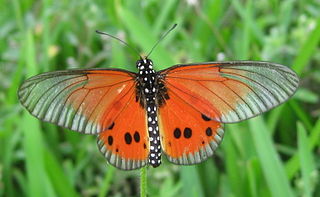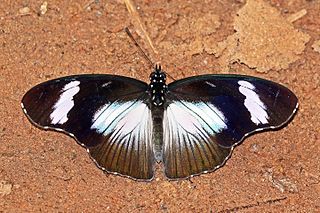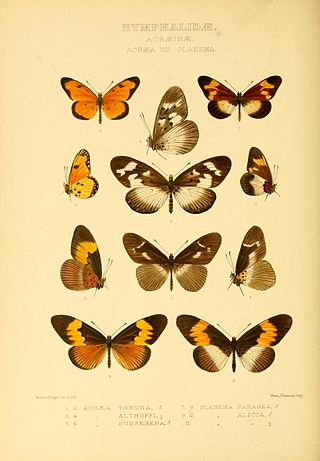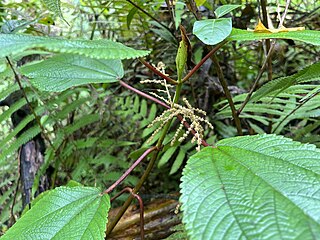
Kapa is a fabric made by native Hawaiians from the bast fibres of certain species of trees and shrubs in the orders Rosales and Malvales. The bark is beaten and felted to achieve a soft texture and dye stamped in geometric patterns.

The Kamehameha butterfly is one of the two species of butterfly endemic to Hawaii, the other is Udara blackburni. The Hawaiian name is pulelehua. This is today a catch-all native term for all butterflies; its origin seems to be pulelo "to float" or "to undulate in the air" + lehua, "reddish", or "rainbow colored", probably due to the predominant color of the Metrosideros polymorpha flower: an animal that floats through the air, from one lehua to another. Alternatively, it is called lepelepe-o-Hina – roughly, "Hina's fringewing" – which is today also used for the introduced monarch butterfly.

The Lānaʻi hookbill is an extinct species of Hawaiian honeycreeper. It was endemic to the island of Lānaʻi in Hawaiʻi, and was last seen in the southwestern part of the island. George C. Munro collected the only known specimen of this species in 1913, which is housed in the Bernice P. Bishop Museum in Honolulu, and saw the species only twice more, once in 1916 and for a final time in 1918. No other sightings have been reported. They inhabited montane dry forests dominated by ʻakoko and ōpuhe. The Lānaʻi hookbill was monotypic within the genus Dysmorodrepanis and had no known subspecies. Its closest relative is believed to be the ʻōʻū, and some early authors suggested that the Lānaʻi hookbill was merely a deformed ʻōʻū. The Lānaʻi hookbill was a plump, medium-sized bird with greenish olive upperparts and pale whitish yellow underparts. It also had a yellow or white superciliary line and a white chin and throat. The wings also had a distinctive and conspicuous white wing patch. The hookbill's distinguishing characteristic was its heavy, parrotlike bill, which had the mandibles hooking sharply towards each other, leaving a gap between them when the beak was closed.

Urera is a genus of flowering plants in the nettle family, Urticaceae. It has a pantropical distribution.
Urera expansa is a species of plant in the family Urticaceae. It is endemic to Jamaica.

Urera kaalae, opuhe, is a species of flowering plant in the nettle family, Urticaceae, that is endemic to the island of Oʻahu in Hawaii. It inhabits slopes and gulches in mesic forests at elevations of 300–760 m (980–2,490 ft). Currently it is restricted to the southern and central parts of the Waiʻanae Mountains. Associated plants include maile, hame, Asplenium kaulfusii, Athyrium spp., ʻāwikiwiki, pāpala, ʻakoko, poʻolā, ēlama, Doryopteris spp., ʻieʻi.e., manono, Hibiscus spp., olopua, māmaki, hala pepe, ʻālaʻa, kōpiko, heuhiuhi, aʻiaʻi, ōpuhe, and maua. It is threatened by habitat loss.

Acraea igola, the dusky-veined acraea, is a butterfly of the family Nymphalidae. It is found from the Eastern Cape along the coast to KwaZulu-Natal, Zimbabwe, Mozambique, north-eastern Tanzania.

Hypolimnas anthedon, the variable eggfly or variable diadem, is a species of Hypolimnas butterfly found in southern Africa. There are four known subspecies, but it is very variable species with many morphs.
Udea platyleuca is a moth of the family Crambidae. It is endemic to the Hawaiian islands of Oahu, Molokai, Maui and Hawaii.
Spheterista urerana is a moth of the family Tortricidae. It was first described by Otto Swezey in 1915. It is endemic to the Hawaiian island of Oahu.
Philodoria urerana is a moth of the family Gracillariidae. It was first described by Otto Swezey in 1915. It is endemic to the Hawaiian islands of Oahu and Hawaii.
Cyanea procera is a rare species of flowering plant in the bellflower family known by the common name Molokai cyanea. It is endemic to Hawaii, where it is known only from the island of Molokaʻi. It is a federally listed endangered species of the United States. Like other Cyanea it is known as haha in Hawaiian.

Salamis cacta, the lilac mother-of-pearl or lilac beauty, is a butterfly in the family Nymphalidae. It is found in Senegal, Guinea, Sierra Leone, Liberia, Ivory Coast, Ghana, Togo, Benin, Nigeria, Cameroon, Equatorial Guinea, Gabon, the Republic of Congo, the Central African Republic, Angola, the Democratic Republic of Congo, Uganda, Rwanda, Ethiopia, Kenya, Tanzania, Malawi, Mozambique and Zimbabwe. The habitat consists of forests, including disturbed forest habitats.

Acraea aurivillii, the large alciope acraea, is a butterfly in the family Nymphalidae. It is found in Sierra Leone, Liberia, Ivory Coast, Ghana, Nigeria, Cameroon, Gabon, the Republic of the Congo, the Central African Republic, the Democratic Republic of the Congo, Burundi, Uganda, Kenya, Tanzania, Zambia and Ethiopia. The habitat consists of forests.

Urera baccifera is a species of flowering plant in the nettle family known by many common names, including scratchbush, ortiga brava, pringamoza, mala mujer, chichicaste, nigua, guaritoto, ishanga, manman guêpes, and urtiga bronca. It is native to the Americas from Mexico through Central America into South America, as well as the Caribbean.

Scepocarpus trinervis (Hochst.) Friis & Immelman is a softly woody dioecious liane, sometimes epiphytic, climbing to 20 m, often to the canopy and hanging in festoons. It is one of some 44 species of Urera belonging to the nettle family Urticaceae. It is known in English as the tree climbing-nettle or climbing nettle.
Drosophila hemipeza is an endangered species of Hawaiian fly in the family Drosophilidae. This species is a member of the planitiba subgroup of the picture-wing clade of Hawaiian Drosophila.
Drosophila aglaia is an endangered species of fly from Hawaii. This species is a member of the aglaia subgroup of the picture-wing clade of Hawaiian Drosophilidae. It is only found on the island of Oahu, and has not been observed since 1997, when it was found in Palikea.
Drosophila montgomeryi is an endangered species of fly from the lineage of Hawaiian Drosophilidae. It is found on the island of Oahu.

Boehmeria grandis, commonly called ʻakolea, is a flowering species of the Urticaceae family that is endemic to the Hawaiian Islands. ʻakolea can be found in mesic to wet forests across Hawaiʻi along streams, on ridges, and valley floors. Multiple sources have cited observations in Makaua Gulch on Oʻahu.











